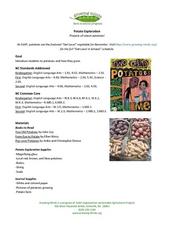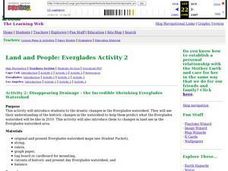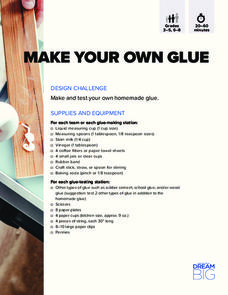Curated OER
Vector Lab
Here is a math lab that helps young mathematicians understand the real-life meaning for vector addition. By building a model using spring scales and washers as weight, and then calculating the vector addition using two different methods,...
Curated OER
Muscular and Skeletal Systems
How do muscles move bones? Find out using a built-in-class model. Pupils construct a hand model with paper and string, then follow a series of directions to explore the movement process. Discover additional information about the muscular...
Curated OER
Waterskiing in Circles
High schoolers discuss and give examples of Newton's three laws. They then answer questions in reference to Newton's three laws. One example of the questions that students answer is: A water-skier typically uses a 75 foot tow rope. The...
Growing Minds
Potato Exploration: Projects All About Potatoes!
How many potatoes tall are you? Unearth this rich resource! A reading of John Coy’s Two Old Potatoes begins a cross-curricular exploration of potatoes. Class members read, write, weigh, measure, and experiment with potatoes. Additional...
Curated OER
Activity 2: Disappearing Drainage - the Incredible Shrinking Everglades Watershed
Students examine drastic changes in Florida Everglades watershed, compare and contrast two watershed maps, discuss effects of addition of agriculture, loss of wetlands, and introduction of Water Conservation Areas, and predict condition...
Curated OER
Balloon Rockets
Students, after reviewing and analyzing Newton's third law of motion, make balloon rockets and experiment with a variety of models. After the experiment, they chart the results and form conclusions. In addition, they compare/contrast...
DiscoverE
Make Your Own Glue
You won't regret being stuck with this activity. By mixing a variety of household items, pupils create their own glue. They test the tensile strength of their glue and compare it to that of other adhesives.
Curated OER
Jumpy Dolls
Students are challenged to design and construct a jointed figure that moves in a motion something like jumping jacks when a string is pulled.
Curated OER
Styrofoam Earth
Students examine how there are three layers inside the Earth. They design their own model of the layers of the Earth with a Styrofoam ball. They illustrate the layers inside the Earth with crayons.
Curated OER
Peanut Processes
Students use the senses are to make observations about phenomena. They use a peanut and its shell as the object of a series of observations. In addition, they complete a drawing with their written observations to use as a guide to choose...
Curated OER
How Big is a Crowd?
Sixth graders compare the relative sizes of the five Great Lakes and their human populations. They describe some of the problems that arise when many people depend on a limited resoure. Students discuss how the Great Lakes and the...
Curated OER
Science: The Water Cycle
Students examine the various stages of the water cycle. In groups, they complete a hands-on activity by creating model water cycle. Students design posters representing each of the seven stages of the water cycle.
Curated OER
Habitat Survey
Students observe a local habitat. They stake out a survey site with string and collect samples for their soil separation and Tullgren funnel tests. In addition, they analyze collected data.
Cornell University
Constructing and Visualizing Topographic Profiles
Militaries throughout history have used topography information to plan strategies, yet many pupils today don't understand it. Scholars use Legos and a contour gauge to understand how to construct and visualize topographic profiles. This...
Teach Engineering
Stop the Stretching
Stretch your teaching repertoire with an experiment on the elongation (stretching) and failure (break) of several materials. The point of the experiment is to design a composite material for chair webbing.
DiscoverE
Build a Pinball Game
Watch your classroom turn into an arcade. Pupils work in groups to build pinball machines from boxes and other found objects. Gamers must incorporate a variety of obstacles and launchers into the machine to see their designs in motion.
Curated OER
Great Lakes Food Web
Students identify species and components of a Great Lakes food web. Using note cards, they place themselves in the correct order of the food chain based on the species present. They discuss what they believe happens to various species...
Curated OER
Build a Hawaiian Bird
Fifth graders make a model of a bird. In this animal adaptations lesson, 5th graders examine how birds adapt to their environment, using Hawaiian birds as an example. Students create their own bird using adaptation paper cut outs...
Curated OER
Turtle Hurdles
Students explore physical education by researching biology. In this survival techniques lesson, students discuss the methods turtles use to survive dangerous encounters and conduct a sea turtle role play exercise. Students identify the...
Curated OER
Insects: Grasshoppers
Students examine grasshoppers as they practice following instructions. In this biology lesson plan, students identify the characteristics of grasshoppers and the functions of grasshoppers' external body parts.
Curated OER
See That Sound?
Students study sonar and will explain the concept of it and its major components. In this design lesson students build a low-cost sonar system.
Curated OER
Making Objects Move
Students will make many discoveries about how and why objects move. They will explore and manipulate the motion of objects and the forces required to control that motion (pushing, pulling, throwing, dropping, rolling, and so on). This...
Curated OER
Habits of Mind
Students study tree leaves to complete the activity, In this tree leaf experiment lesson, students observe, measure, and sort tree leaves individually, in groups, and in relationship to the entire tree.






















